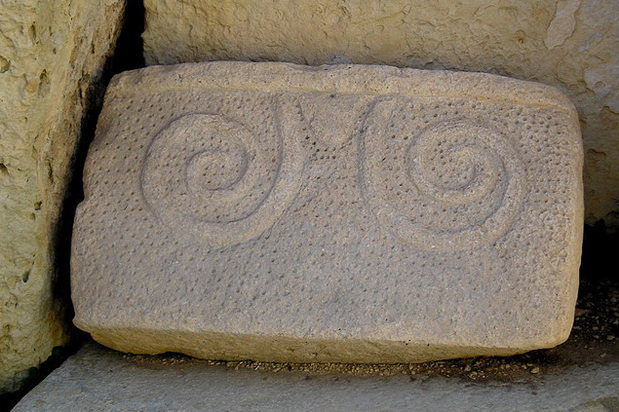Ggantija Temples in Gozo, a UNESCO World Heritage Site, are older than the pyramids in Egypt and date back to between 3600 and 3200 BCE (and possibly even earlier). These megalithic temples are considered to be the second oldest man-made structure in the world. The temples are actually two temples built next to each other (North and South) and each have five semi-circular apses with several altars. The largest standing stone is six meters high.
According to the local legend, the temples were built overnight by a giant woman with a baby at her breast. She ate a meal of only broad beans and then carried huge blocks of stone to build the walls of the structure. Behind the simplicity of the legend lies its important point, the lingering in the collective memory of the worship of a feminine Creatrix. Emblematically, a woman with a baby at her breast was not a helpless traveller looking for shelter, but a giantess who built a temple overnight.

The unique architectural feature of Ggantija, and all Maltese temples in general, is the absence of straight lines. Even the internal decorations are based on the shape of a spiral, resembling the curving lines of a snake. In fact, the oldest spirals to have ever been recorded in the world are found in the walls of Ggantija temples in Gozo. They are too faint to be seen with a naked eye by now, but the spirals in Tarxien temples, which were built built around 3600 to 3200 BCE, are clearly visible in the picture below:

The temples were likely used as a place of Goddess worship. According to some researchers, even the shape of the temples symbolically represents the body of the Great Mother (in much the same way as many Christian churches are built in the shape of a cross).
The abundance of temples in the Maltese islands suggests they were probably also a place of pilgrimage, perhaps the most important one in the Mediterranean region at the time. For three millennia, from around 5200 BCE, the Maltese islands were home to a temple-building civilization, whose traces abruptly disappear at around 2500 BCE.
These temples are much more complex than anything we know was built or constructed in the world at that time. While it is difficult to interpret the exact events and practices that surrounded the building and functioning of Ggantija temples, they offer a fascinating window into the world thousands of years ago. Lack of known history from these times provides ample opportunity for speculation and theories regarding the function and role of the temples.
For example, many have speculated that Ggantija, along with other Maltese temples were part of the Atlantean civilization, which later gave origin to the civilization of Egypt. Others have disputed the accepted dating of the temples, and pointed out their orientation to the star Sirius.
Just 400 meters opposite Ggantija temples, one may find an underground prehistoric burial site, the so-called Xaghra Stone Circle. It used to be a walled enclosure with natural underground burial caves. The entrance to the burial site was facing Ggantija, which may suggest a connection between the two. The earliest burials here date to around 4000 BCE, but it was extensively used until about 2500 BCE, until it eventually collapsed. The site is protected and is not accessible to the public.
Limestone statuettes and artifacts that were deposited in the burial site can now be seen in Ggantija museum and the Gozo Museum of Archaeology in the Citadel.
Not far from the Stone Circle, the remains of the Sta Verna Temple in Xaghra are only a few megaliths, but it is possible this temple had been built before Ggantija and had an even greater importance. Unfortunately, very little of it survived to the present day.
Visit Ggantija as part of the Gozo Highlights Tour to make the most of your day in Gozo.

